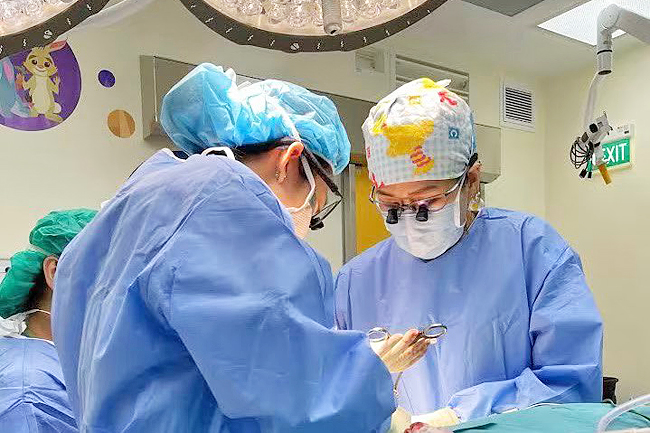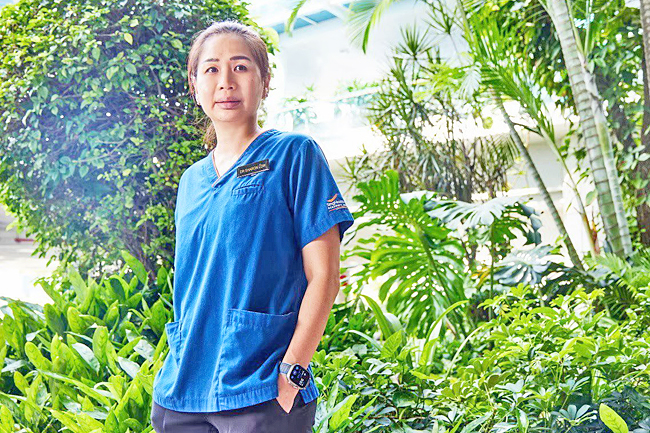CNA – Several interviews with Dr Sharon Low were originally scheduled on Monday morning.
But the meetings were postponed at the last minute as the paediatric neurosurgeon at KK Women’s and Children’s Hospital (KKH), had to perform emergency brain surgery on a child.
When I finally caught up with Dr Low in her office the next day, it was naturally the first thing I asked about.
“A toddler had been referred here because her mum noticed that she kept falling to one side.
After an MRI, they found a brain tumour with hydrocephalus, a condition where there is excess fluid accumulated in the brain,” she said.
The significant fluid accumulation had caused high pressure in the toddler’s brain and timely surgery was necessary to save the patient’s life.
Dr Low arranged for the surgery within 24 hours.
A small hole was made in the toddler’s skull, and another small opening was made in another part of the brain to allow the excess fluid to flow through and alleviate the high pressure in the brain.
At the same time, tissue was extracted from the tumour for testing.


A DAY IN THE LIFE OF A NEUROSURGEON
Such time-sensitive, high-stakes surgeries are fairly common for the 46-year-old neurosurgeon.
As Head of Neurosurgical Service at KKH she performs between one and five such surgeries weekly.
In fact, the surgery she just shared with CNA Women is considered a fairly straightforward procedure in the world of neurosurgery, explained Dr Low. It was completed in about an hour.
The field of neurosurgery is known to be more complicated because it involves the brain and spinal cord, she pointed out.
A complex brain tumour surgery may take four to six hours. However, Dr Low once did a surgery that lasted for 20 hours.
“The patient was a very young child with a large and malignant tumour that went from the brain through the skull base and into the nose. It was a joint effort between myself, the ENT (ear, nose and throat) surgeons and the plastic surgeons to clear the tumour and reconstruct the face,” she said.
Dr Low said she is one of only three dedicated paediatric neurosurgeons in Singapore, all of whom are based at KKH – of the three, she is the only woman.
Other neurosurgeons who primarily treat adults may offer paediatric neurosurgery as a sub-specialty.
Her patients range from a day old to 19 years old. She treats brain and spine tumours, hydrocephalus, head injuries, and other conditions involving the brain and spinal cord, such as brain cysts, brain infections and certain birth defects.
There is no margin for error in neurosurgery.
“If you cause injury to any of the brain or spine structures, the patient might end up being paralysed, in a vegetative state or dead,” Dr Low said, noting that this has not happened at KKH.
It’s also why medical insurance premiums for neurosurgeons are one of the highest amongst all specialties, she added.
Hours also run long. “When I started training, they told me that is one of those specialties where you don’t get to go home,” she laughed.
This is one reason neurosurgery is not a popular choice among medical students.
In Singapore, there are only 50-plus neurosurgeons. Of these, roughly 10 per cent are women.
In fact, Dr Low said she is the second female neurosurgeon in Singapore – the first is from the United Kingdom. She started practising in 2016 and three other female neurosurgeons joined the speciality after. So today, there are five female neurosurgeons practising locally, she said.
Dr Low continues to push herself in the field, waking up each day at 4.30am and ending her day around 10pm or 11pm.
She divides her time between surgery, seeing patients in the clinic, research work, manpower planning, education and training, as well as other administrative duties as head of neurosurgical service at KKH.
Once a month, she sees patients at an adult clinic in Tan Tock Seng Hospital, and she treats adult brain tumour patients referred to her at the Singapore General Hospital on an ad hoc basis.
KEEPING HOPE AGAINST ALL ODDS
When it comes to brain tumours, sometimes the outlook can be bleak. One of the most difficult parts of Dr Low’s job is sharing bad news with parents and discussing medical treatment options.
“If you are 60 years old, for example, have led a pretty full life and are diagnosed with a terminal disease, the acceptance may not be easy, but it would not be too bad because you have led a big part of your life.
“But if you’re six years old, you’re barely starting, and I have to tell you that it’s terminal or a very poor prognosis, you can imagine how difficult this would be for parents to accept,” she said.
Even doctors feel the sense of loss acutely. “When I was doing more adult neurosurgery, I already thought life was short. But doing paediatric neurosurgery makes me realise that life can be even shorter than you think,” she reflected.
That said, even in the case of a bad prognosis, Dr Low fights against the odds.
“I treated a child with a very difficult brain cancer where the life expectancy was about two years, so everybody expected him to pass on. He is a great kid and it was particularly sad because the mum told us that they tried very hard to conceive before they had him,” she recalled.
“What made me really happy was that he is still alive today, six years after surgery, and has transitioned into adulthood thanks to the advancement in drugs,” added Dr Low, who keeps track of many of her brain tumour patients even when they are no longer under her care.
“Doing paediatric neurosurgery makes me realise that life can be even shorter than you think.” It is in the hopes of beating seemingly impossible odds that Dr Low actively contributes to research on paediatric brain tumours.
“We collect leftover tumours that the pathologist doesn’t need and try to understand their biology in the laboratory to figure out what drives them, what makes them grow more, what kills them,” she said.
She believes that such research can make a difference in the way brain tumours will be treated in future.
“In the past, neurosurgeons were very heavily relied on to take out tumours in their entirety as much as possible because there was no medicine to ‘melt’ the tumours.
“But nowadays, there are more options for some brain tumours. And with more research, aggressive surgery may not be the main option when treating brain tumours in time to come,” she reflected.
Dr Low, who is married but has no children, said it is her young patients and their parents who inspire and motivate her.
“I see how strong parents are for their kids, giving up whatever they have to give up just to be with their child day in, day out as they go through treatment.
“Some of them quit their jobs, some of them take time off work, some of them move their whole office into the hospital room, and do work while the child is sleeping.
“They just don’t give up no matter what. I’m not strong compared to them,” she reflected. Ward rounds are also very fulfilling.
“Children in general don’t know what’s going on and will never cease being happy even when they are really sick. They would still be as cute as ever,” she said.
“A lot of the kids I work with are very resilient, physically and mentally,” she added thoughtfully.
“Somehow, they get through the pain and kind of move on without the emotional complexity that adults may experience. Working with children makes me realise that they can defy the odds,” she said. – Annie Tan


